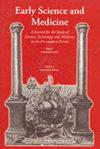在物质与形式之间:肤色(mizāǧ)是阿维森纳科学计划的基石
IF 0.5
2区 哲学
Q3 HISTORY & PHILOSOPHY OF SCIENCE
引用次数: 0
摘要
根据阿维森纳的观点,完全的(或完全的)倾向(isti ā dād kāmil/tāmm)把潜在地接受每一种形式(或力量或性质)的原始物质变成具有统一性质的完整物质。后者,即肤色(mizāǧ)或络合形式(ṣūra mizāǧiyya),适合接受某种特定的形式(或力量或质量),而不是另一种形式。问题是,物质是怎样形成它的特殊面貌的。它是天体影响的结果,还是物质内部化学元素相互作用的结果?本文试图用阿维森纳的自然哲学和形而上学的文本证据来回答这个问题。与灵魂/形态一起,完整的物质代表了有机的、有生命的物质的其他组成部分。然后,论文试图确定哪种科学适合其研究。我认为,对有机物质的研究,即动物身体(或其各部分)特有的肤色,属于动物学。动物学是基础医疗实践的关键,它对那些特定的肤色进行操作,以保持或恢复健康。本文章由计算机程序翻译,如有差异,请以英文原文为准。
Between Matter and Form: Complexion (mizāǧ) as a Keystone of Avicenna’s Scientific Project
According to Avicenna, the perfect (or complete) disposition (istiʿdād kāmil /tāmm ) turns prime matter, which is potentially receptive to every form (or power, or quality), into complected matter, which is endowed with uniform quality. The latter, i.e., complexion (mizāǧ ) or complexional form (ṣūra mizāǧiyya ), is suitable to receive some particular form (or power, or quality) and not another. The question arises as to how matter acquires its specific complexion. Is it the result of celestial influence, or does it emerge from chemical, elemental interactions within matter? This paper tries to answer this question with textual evidence from Avicenna’s natural philosophy and metaphysics. Together with soul/form, complected matter represents the other constituent of organic, living substances. The paper then attempts to determine which science is proper to its investigation. I argue that the investigation of organic matter, that is, the specific complexion characterizing the animal body (or its parts), pertains to zoology. Zoology is crucial to grounding medical practice, which operates on those specific complexions to preserve or restore health.
求助全文
通过发布文献求助,成功后即可免费获取论文全文。
去求助
来源期刊

Early Science and Medicine
HISTORY & PHILOSOPHY OF SCIENCE-
CiteScore
0.50
自引率
0.00%
发文量
22
审稿时长
>12 weeks
期刊介绍:
Early Science and Medicine (ESM) is a peer-reviewed international journal dedicated to the history of science, medicine and technology from the earliest times through to the end of the eighteenth century. The need to treat in a single journal all aspects of scientific activity and thought to the eighteenth century is due to two factors: to the continued importance of ancient sources throughout the Middle Ages and the early modern period, and to the comparably low degree of specialization and the high degree of disciplinary interdependence characterizing the period before the professionalization of science.
 求助内容:
求助内容: 应助结果提醒方式:
应助结果提醒方式:


